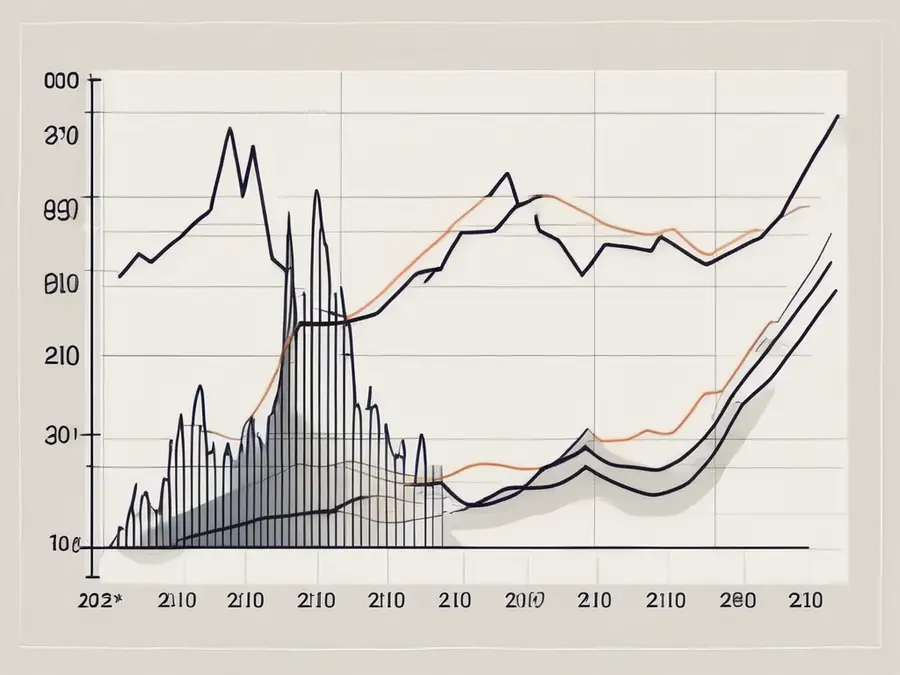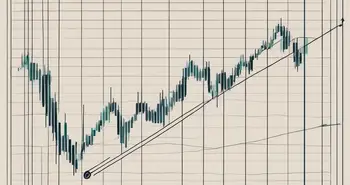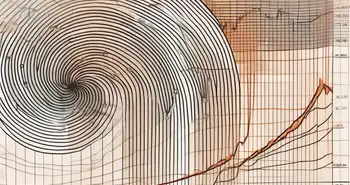Do Fibonacci Retracements Really Work?

As a trading expert with years of experience, I am often asked whether Fibonacci retracements are truly effective in the world of trading. In this article, I will delve into the intricacies of Fibonacci retracements, their mathematical basis, their role in trading, and the controversy surrounding their efficacy. So, let's dive in and explore the fascinating world of Fibonacci retracements!
Understanding Fibonacci Retracements
Before we can assess the effectiveness of Fibonacci retracements, it is crucial to understand what they are and how they work. Fibonacci retracements are a technical analysis tool used to identify potential support and resistance levels in price movements. These levels are derived from the Fibonacci sequence, a mathematical sequence in which each number is the sum of the two preceding ones.
The Mathematical Basis of Fibonacci Retracements
Leonardo Fibonacci, an Italian mathematician from the 13th century, introduced the Fibonacci sequence to the Western world. This sequence has intriguing mathematical properties and is closely tied to the “Golden Ratio” of 1.618.
The Fibonacci sequence starts with 0 and 1, and each subsequent number is the sum of the two preceding ones. So, the sequence goes like this: 0, 1, 1, 2, 3, 5, 8, 13, 21, and so on. This sequence has fascinated mathematicians and traders alike for centuries.
When applied to trading, Fibonacci retracements are used to identify potential price levels where a correction or reversal may occur. Traders believe that these levels often act as significant support or resistance zones in the market.
The Role of Fibonacci Retracements in Trading
Traders use Fibonacci retracements in conjunction with other technical analysis tools to identify potential entry and exit points in the market. The idea is that when a market is trending, it tends to retrace a portion of its previous move before continuing in the original direction.
By applying Fibonacci retracements to a trending market, traders can identify levels where the price is likely to encounter support or resistance. These levels can help traders make informed decisions about when to enter or exit a trade.
For example, if a stock is in an uptrend and has experienced a significant price increase, traders can use Fibonacci retracements to identify potential levels where the stock may retrace before continuing its upward movement. These retracement levels, such as 38.2%, 50%, or 61.8%, are derived from the Fibonacci sequence and are believed to be areas where the stock may find support.
Similarly, in a downtrend, Fibonacci retracements can help traders identify potential levels where the price may retrace before continuing its downward movement. These levels can act as resistance, providing opportunities for traders to enter short positions.
It is important to note that Fibonacci retracements are not foolproof and should be used in conjunction with other technical analysis tools and indicators. Traders often combine Fibonacci retracements with trendlines, moving averages, and oscillators to increase the accuracy of their trading decisions.
In conclusion, Fibonacci retracements are a valuable tool in the arsenal of technical analysts and traders. By identifying potential support and resistance levels based on the Fibonacci sequence, traders can make more informed decisions about when to enter or exit trades. However, it is important to remember that no trading strategy is infallible, and proper risk management is crucial in any trading endeavor.
The Controversy Surrounding Fibonacci Retracements
While Fibonacci retracements have gained popularity among many traders, they are not without their skeptics. Let's explore the reasons behind the skepticism and the ongoing scientific debate surrounding their effectiveness.
Skepticism in the Trading Community
Some traders question the reliability of Fibonacci retracements, arguing that they are purely based on historical data and have no predictive power. They believe that using them as a sole trading strategy can lead to poor decision-making and subpar results.
However, it is important to note that the skepticism surrounding Fibonacci retracements is not unfounded. Traders who rely solely on these retracement levels may overlook other crucial factors that influence market movements. Market sentiment, economic indicators, and geopolitical events are just a few examples of external factors that can significantly impact the price action, rendering Fibonacci retracements less effective in isolation.
Additionally, critics argue that the use of Fibonacci retracements can sometimes lead to self-fulfilling prophecies. As more traders incorporate these levels into their analysis, the increased buying or selling activity around these points can artificially create support or resistance levels, distorting the market's natural dynamics.
Therefore, it is widely accepted in the trading community that Fibonacci retracements should not be used as a standalone strategy. Instead, they should be used in conjunction with other technical analysis tools and indicators to confirm or validate potential trading opportunities.
The Scientific Debate
The scientific community is divided on whether Fibonacci retracements have any real statistical significance in the financial markets. While some studies suggest a correlation between Fibonacci retracements and price levels, others contest these findings, pointing to the lack of a clear cause-and-effect relationship.
Proponents of Fibonacci retracements argue that these levels can provide valuable insights into support and resistance levels. They believe that the inherent mathematical relationships found in the Fibonacci sequence can influence market behavior, as traders may subconsciously react to these levels when making trading decisions.
On the other hand, skeptics argue that any observed correlation between Fibonacci retracements and price levels may be coincidental or a result of data mining. They emphasize the need for rigorous statistical analysis and controlled experiments to establish a causal relationship between Fibonacci retracements and market movements.
As a trading expert, I have found that Fibonacci retracements can indeed provide valuable insights into support and resistance levels, but it is essential to corroborate them with other technical indicators and fundamental analysis. By combining multiple tools and approaches, traders can increase their chances of making informed trading decisions and managing risk effectively.
In conclusion, while Fibonacci retracements have their fair share of skeptics and ongoing scientific debate, they remain a popular tool among traders. However, it is crucial to use them as part of a comprehensive trading strategy and to consider other market factors to achieve consistent and successful trading outcomes.
Evaluating the Effectiveness of Fibonacci Retracements
Assessing the effectiveness of Fibonacci retracements relies on understanding the factors that influence their success and debunking common misconceptions surrounding them.
Factors Influencing the Success of Fibonacci Retracements
The success of Fibonacci retracements depends on various factors, such as the timeframe of analysis, the extent of market volatility, and the presence of significant news events. It is crucial to adapt the application of Fibonacci retracements to the specific market conditions at hand.
Common Misconceptions about Fibonacci Retracements
One common misconception is that Fibonacci retracements provide infallible precision in predicting price levels. While they can be useful for identifying potential support and resistance zones, they are not foolproof indicators of future price movements. Proper risk management and sound decision-making are still essential.
Practical Application of Fibonacci Retracements
When applying Fibonacci retracements to a trading strategy, it is crucial to consider the practical aspects and potential risks and rewards.
Incorporating Fibonacci Retracements into a Trading Strategy
To incorporate Fibonacci retracements effectively, traders should combine them with other technical indicators, such as moving averages or trend channels. This holistic approach helps validate potential support and resistance levels, increasing the probability of successful trades.
It is essential to remember that no trading strategy or tool guarantees success. Surrounding yourself with a solid educational foundation, staying informed about market trends, and continuously refining your trading approach are key to achieving consistent results.
Potential Risks and Rewards
Like any trading tool, Fibonacci retracements come with their own set of risks and rewards. It is important to set realistic expectations and manage risk effectively. Properly leveraged, Fibonacci retracements can provide valuable insights into potential market turning points, but they should never be solely relied upon for decision-making.
The Future of Fibonacci Retracements
The world of trading is continuously evolving, and so are the tools and techniques used by traders. In recent years, technological advancements have made Fibonacci retracements more accessible and user-friendly.
Technological Advancements and Fibonacci Retracements
New trading platforms and charting software now incorporate Fibonacci retracements as a built-in tool, making it easier for traders to apply them to their analysis. This integration has improved the visibility and usability of Fibonacci retracements, allowing traders to make more informed decisions.
The Evolving Perception of Fibonacci Retracements in the Trading World
While the debate surrounding the effectiveness of Fibonacci retracements continues, traders continue to use them as a part of their analysis toolkit. Whether they are seen as a reliable trading tool or not, Fibonacci retracements have undoubtedly left a lasting impact on the trading world.
As an expert in the field, I have personally witnessed the benefits and limitations of Fibonacci retracements. They provide valuable insights when used in conjunction with other technical analysis tools, helping traders make more informed decisions.
FAQ – Frequently Asked Questions
Are Fibonacci retracements a standalone trading strategy?
No, Fibonacci retracements should not be used as a standalone trading strategy. They should complement a trader's overall strategy, incorporating other technical indicators and fundamental analysis.
What factors should I consider when applying Fibonacci retracements?
Factors such as timeframe, market volatility, and significant news events influence the success of Fibonacci retracements. Adapt the application of Fibonacci retracements to the specific market conditions you are trading.
Is it possible to predict price levels accurately with Fibonacci retracements?
No, it is not possible to predict price levels with absolute precision using Fibonacci retracements alone. They provide potential support and resistance zones, but risk management and sound decision-making must accompany their use.
Do Fibonacci retracements have statistical significance in the financial markets?
The scientific community is divided on whether Fibonacci retracements have statistical significance. While some studies suggest a correlation between Fibonacci retracements and price levels, others argue against a clear cause-and-effect relationship.
How can I incorporate Fibonacci retracements effectively into my trading strategy?
To incorporate Fibonacci retracements effectively, combine them with other technical indicators and analysis techniques. This holistic approach helps validate potential support and resistance levels, increasing the probability of successful trades.
While Fibonacci retracements may not possess mystical predictive powers, they do offer valuable insights when used responsibly. By understanding their mathematical basis, their practical application, and the ongoing debate surrounding their efficacy, you can make informed decisions in your trading journey.
Remember, success in trading comes from a combination of knowledge, experience, adaptability, and a disciplined approach. Use Fibonacci retracements as a tool in your arsenal, but never let them overshadow the importance of continuous learning and honing your trading skills.
Ready to put Fibonacci retracements to the test in a dynamic trading environment? Look no further than Morpher, the revolutionary trading platform that's changing the game with zero fees, infinite liquidity, and the power of blockchain technology. Whether you're interested in stocks, cryptocurrencies, forex, or even niche markets, Morpher offers the flexibility of fractional investing and short selling, along with the security of a non-custodial wallet. Amplify your trades with up to 10x leverage and experience a unique trading journey with Virtual Futures. Sign Up and Get Your Free Sign Up Bonus today to start trading on a platform that's as innovative as your strategies.

Disclaimer: All investments involve risk, and the past performance of a security, industry, sector, market, financial product, trading strategy, or individual’s trading does not guarantee future results or returns. Investors are fully responsible for any investment decisions they make. Such decisions should be based solely on an evaluation of their financial circumstances, investment objectives, risk tolerance, and liquidity needs. This post does not constitute investment advice.

Painless trading for everyone
Hundreds of markets all in one place - Apple, Bitcoin, Gold, Watches, NFTs, Sneakers and so much more.

Painless trading for everyone
Hundreds of markets all in one place - Apple, Bitcoin, Gold, Watches, NFTs, Sneakers and so much more.









